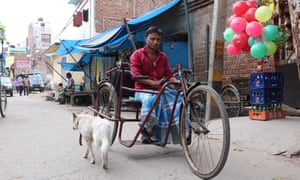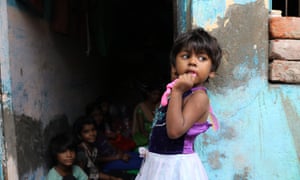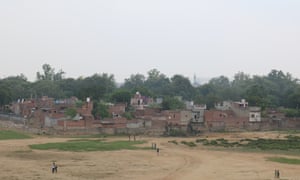The first lesions appeared on teenager Rammurat’s feet. To those in his village near Gorakhpur, in the vast Indian state of Uttar Pradesh, the cause of the pale sores was clear.
“Some said it was black magic. Some said it was the spirit of the dead catching us,” he recalls.
“What will people think? What will the neighbours think?” he wondered when finally diagnosed at a nearby mission hospital – too late to entirely save his feet. “People used to hate looking at a leprosy patient. You see a lady [with symptoms] coming into the village, they will run away.”
India is officially leprosy free, meaning the disease afflicts fewer than one in 10,000 people. But specialists understand the true infection rate to be far higher, and the disease is still endemic in some of the country’s poorest districts.
Today India accounts for more than 60% of the world’s new leprosy cases and health officials have quietly moved to a “war footing” against it, one senior researcher says.
This week the government announced a major step: the world’s first leprosy vaccine, developed in-country but tied up for years in testing, will be rolled out in Gujarat and Bihar, two states where the problem is sharpest.
Among the oldest recorded references to leprosy – the ulcers, the gnawing away of a fingers, eyes and noses – appear in 4,000-year-old Hindu epics, the disease christened kustha, Sanksrit for “eating away”.
Long associated with sin and contagion, one Vedic legend holds that even a king was banished after developing the telltale sores. Rammurat, a 14-year-old when his symptoms appeared, sought treatment, but stood no chance against the stigma.

Older now, Rammurat lives in a 30-hectare slum on Delhi’s north-eastern fringes. Rubbish collects in open sewers along the tight lanes of the neighbourhood and children mingle with tethered goats and chickens in the midday heat. It could be any poor community in the capital, but for the preponderance of wounds: missing toes, fingers, or entire limbs wrapped in white gauze.
Allotted to people with the disease a half-century ago, these blocks in Tahir Pur have grown into Asia’s largest leprosy colonies, home to 2,000 patients and their families, and a remnant of centuries of official policy to segregate them from the world. Rammurat arrived 25 years ago, seeking acceptance and access to treatment. “I moved here to save myself,” he says.
A few hundred metres away is the Leprosy Mission’s Delhi hospital, one of 14 specialist care centres the Christian group runs in India. Inside, hundreds crowd around waiting rooms and dispensary windows awaiting medicine, among them up to 150 leprosy patients each day.
It diagnoses on average one new case of the disease per day. “That’s alarming,” says Stephen Levi, the hospital’s superintendent. “And when we ask them to bring their other family members in, they don’t.”
Beside psalms and lists of symptoms on the hospital’s tiled walls there are, less congruously, pictures of the nine-banded armadillo: the north American mammal the only other species to naturally host leprosy, and a boon for researchers, who are still unable to grow the disease in labs.
For all the fear it conjures, leprosy, caused by the pathogen Mycobacterium leprae, has been effectively treatable since the 1940s. It isn’t particularly contagious either, its spread requiring regular contact with an untreated sufferer, and an immune system already compromised by genetics or poverty. Nor is it “flesh-eating” – limbs more likely to rot away because of injuries sustained by repeated use after the sensation of pain is lost.
“The real problem is the level of stigma,” says Dr Sunil Anand, the executive director of the Leprosy Mission. “Those who get leprosy tend to be ostracised and stigmatised by the community, they tend to hide away.”

That makes containing the disease, or treating it before disfigurement sets in, harder. “Discriminatory practices then come into play. Like schools not giving admission to children with leprosy, or from a leprosy family. It’s the same in jobs, even healthcare,” he says.
About 16 national Indian laws still discriminate against people with leprosy, he says, a legacy of the ancient aversion to the disease, but also an 1898 colonial law that segregated patients and prevented them having children, passed in response to British panic an epidemic would spread back home.
A eight-year treatment drive by the Indian government shrunk the number of new cases four-fold by 2005. That year the government celebrated the official elimination of the disease, meaning a rate of fewer than one in 10,000 new cases a year. “Maybe that’s possible,” Levi, the hospital superintendent, says of the official rate. “But only because India has such a huge population.”
One of India’s leading leprosy researchers, Dr Uptal Sengupta, is more sceptical. The elimination figure trumpeted by the government and World Health Organisation was produced “in a hurry”, the 75-year-old says from his office, a bobble-headed armadillo on the desk.
More recent leprosy surveys produced by the Indian Council of Medical Research (ICMR) have a much greater prevalence, he says, but the Indian government has declined to release the exact estimate. (A source with access to the research told the Guardian the research showed a national rate of “roughly five to six cases per 10,000”.)
Battling high rates, health officials are also racing against time: leprosy strains are slowly becoming resistant to the multi-drug therapy that so successfully brought the Indian infection rate crashing down.
“When there was a monotherapy, it took only 30 years for the disease to develop resistance,” Sengupta says. “And we are already seeing resistance cases [for the multi-drug therapy].”

The rollout of the vaccine, announced earlier this month, is part of a return to a “war footing” against the disease, he says. “The vaccine is the most important thing for elimination. It’s the best answer.”
Beginning in five hotspot districts in Bihar and Gujarat, the vaccine will be administered both to people with leprosy and those in close and regular contact with them, in combination with the antibiotic Rifampicin. Trials of the vaccine have shown it could bring existing rates down by 65% over three years, according to Dr Soumya Swaminathan, the director-general of the ICMR.
The rollout is accompanied by a new round of “active case detection” – health workers going house-to-house “to hopefully detect new leprosy cases which were undiagnosed in the community”. Fifty districts have already been swept, turning up 5,000 previously undetected cases.
“It’s a multi-pronged attack on leprosy, we’re looking to eliminate it” – a second time – “in the next five to 10 years,” Dr Swaminathan says.
That the vaccine is Indian-developed is also a source of pride. “It shows exactly how Indian research and development can solve our own problems,” she says.
In Delhi at least, efforts to remove the stigma around one of the world’s oldest diseases are also paying off – but not without cost.
As the capital expands, the giant leprosy colonies of Tahir Pur suddenly find themselves on prized land. Businesses are illegally setting up shop and developers are eyeing an area society once spurned. “Now, the non-leprosy people are trying to move in,” Levi says.
India rolls out world"s first leprosy vaccine as fight goes on "war footing"